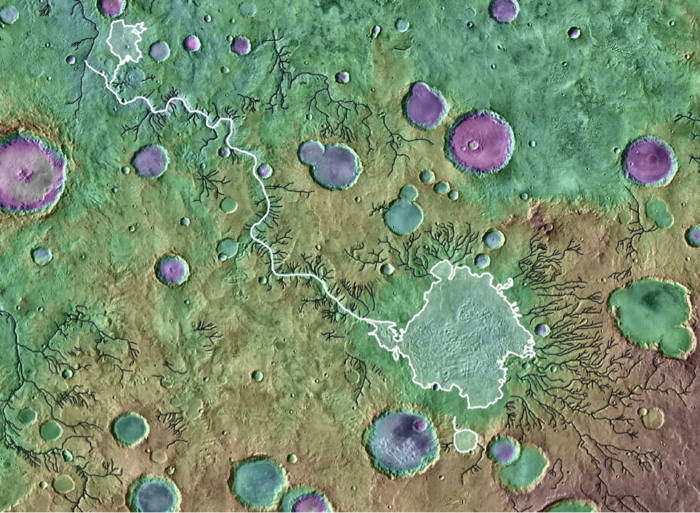The European Space Agency scoped out its own version of a Earth twin-scouting, life-finding mission, called Darwin. Kaltenegger, then 24, applied to work on it and got the job. “I asked myself: If you live in a time where you can figure out if we are alone in the universe, and if I can help?” she said at Cornell, sporting a turquoise gem necklace symbolizing a pale blue dot and balancing a teacup on her knee. “Looking back on my life, that’s probably what I want to have done.” She was tasked with considering the mission’s design trade-offs and drafting the list of stars that Darwin’s fleet of telescopes should scan for planets; in parallel, she pursued her doctorate.
But in the 2000s, visions of grand alien-hunting telescopes crumbled on both sides of the Atlantic. Darwin studies fizzled in 2007. One reason was JWST’s own sagging development schedule, which ate up budgets and attention spans. Another was scientific doubt: At the time, astronomers had no clue what fraction of the Milky Way’s stars have rocky planets with the possibility of a stable, temperate climate.
That fraction would turn out to be about one in five, as revealed by the Kepler space telescope, which launched in 2009 and went on to discover thousands of exoplanets. A Terrestrial Planet Finder mission, should one be resurrected, would have plenty of places to point.
Since Kepler’s launch, though, pragmatic compromises have led astrobiologists to dream smaller, diverting their resources down a humbler path. An observatory like Darwin could have picked out the signal of a rocky planet next to a much brighter star — a challenge often compared to taking a picture of a firefly as it flits around a searchlight. But now there’s another, cheaper way.
Seager and the Harvard astronomer Dimitar Sasselov dreamed up the alternative method in 2000 — a way to sniff into an exoplanet’s atmosphere even if light from the planet and its star are blended together. First, telescopes look for planets that “transit,” crossing in front of their star as seen from Earth’s perspective, which causes a slight diminution in the starlight. These transits are rich with information. During a transit, a star’s spectrum sprouts new bumps and wiggles, because some of the starlight shines through the ring of atmosphere around the planet and molecules in the atmosphere absorb light of specific frequencies. Artful analysis of the spectral wiggles reveals the high-altitude chemistry responsible. The Hubble Space Telescope started testing this technique in 2002, finding sodium vapor around a faraway gas giant planet; along with other telescopes, it has since repeated the trick on dozens of targets.
Now the universe just needed to cough up some suitable Earth-like worlds to look at.
Exoplanet surveys seemed to encounter plenty of overcooked Jupiters and undersize Neptunes around other stars, but rocky planets with the potential for liquid water remained scarce until the Kepler era. By the mid-2010s, Kepler had shown that Earth-size worlds are common; it even spotted some potentially habitable ones transiting in front of their stars, like the pair Kaltenegger modeled for Borucki. Still, the specific examples Kepler turned up were too far away for good follow-up study. Meanwhile, in 2016 astronomers found that the nearest star to Earth, Proxima Centauri, has a potentially habitable Earth-size planet. But that planet doesn’t transit its star.
In 2009, Kaltenegger, then at Harvard and shaping the field in her own right, and a collaborator, Wesley Traub, added yet another qualification. They thought about what it would take for an alien civilization to detect biosignature gases on Earth — a planet with a relatively tight blanket of atmosphere, transiting a bright star. They realized that a telescope like JWST would see only tiny signals from atmospheric gases during each transit, so in order to achieve any statistical certainty, astronomers would need to observe dozens or even hundreds of transits, which would take years. Acting on this insight, astronomers started to seek Earths in close orbits around dimmer, colder red dwarf stars, where atmospheric signals will be less drowned out by starlight and transits repeat more frequently.
The cosmos came through. In 2017, astronomers announced the discovery of seven rocky planets around a red dwarf star called TRAPPIST-1. Then in September, the SPECULOOS-2 system emerged as a backup. These stars are close. They’re dim and red. They each have multiple rocky planets that transit. And as of the summer, the JWST is up and running even better than expected. It will spend a sizable fraction of the next five years staring hard at these messy globes of rock and chemicals spinning around their strange stars. For theoreticians like Kaltenegger who went from daydreaming of alternate Earths to churning out predictions about their atmospheric chemistry, decades of anticipation have given way to a slow fade-in of squiggly spectra on computer monitors.
Glowing Alien Lady
For over two years, Kaltenegger’s office — the same one Sagan used to work in — was frozen in time. First came the pandemic, then a sabbatical. In August, she was back, advancing on her whiteboard with a marker in hand, reviewing a list of ideas that wouldn’t look out of place in the writer’s room of a Star Trek series. (Gaia and SETI. Dark oceans. Ozone. Land. Shallow Oceans. Iron?) “This is the fun part,” she said, striking through the topics of papers she has already published.
Kaltenegger became the founding director of the Carl Sagan Institute in 2015 following stints at Harvard, then in Heidelberg, where she ran her first lab. One day during her time in Heidelberg, an email came in from Jonathan Lunine, now the head of the astronomy department at Cornell, asking if she wanted to talk about important opportunities. “I go, oh my God, it’s a ‘woman in science’ event. At a certain point, you get too many of those invitations.” Lunine was instead looking to hire a new professor. Kaltenegger responded that she would rather work at an interdisciplinary, astrobiology-focused institute. So lead one here, he suggested.
One recent morning we sat in a garden on campus not far from the institute, flanked by rhododendrons. As dappled sunlight filtered down, a little bird hopped up a tree trunk, a cicada buzzed, and the drone of a lawn mower moved nearer, then farther away. This was obviously an inhabited world.
Kaltenegger’s stock in trade is imagination: both the sort that astronomers trust when planning a $10 billion space telescope like JWST, and the more poetic kind that stirs public audiences. So what did this scene look like to her?
She glanced up. The trees had green leaves, as do most known organisms that perform photosynthesis. They had evolved to take advantage of our yellow sun and its bounteous visible-light radiation, using pigments that snatch up blue and red photons while letting green wavelengths bounce away. But plants around colder stars, greedier for light, might take on darker hues. “In my mind’s eye, if I want to, it just completely transforms with us in the garden, sitting under a red sun,” she said. “Everything is purple around you, behind you,” including the leaves.
Uncanny-valley versions of Earth have featured heavily in Kaltenegger’s thinking for two decades, owing to a nagging doubt she developed during her work on the Darwin mission in the early 2000s.
The goal at the time was to compare spectra from rocky, temperate planets to what Earth’s spectrum would look like from far away, seeking conspicuous signals like a surplus of oxygen due to widespread photosynthesis. Kaltenegger’s objection was that, for the first 2 billion years of Earth’s existence, its atmosphere had no oxygen. Then it took another billion years for oxygen to build up to high levels. And this biosignature hit its highest concentration not in Earth’s present-day spectrum, but during a short window in the late Cretaceous Period when proto-birds chased giant insects through the skies.
Without a good theoretical model for how Earth’s own spectrum has changed, Kaltenegger feared, the big planet-finding missions could easily miss a living world that didn’t match a narrow temporal template. She needed to envision Earth as an exoplanet evolving through time. To do this, she adapted one of the first global climate models, developed by the geoscientist James Kasting, which still includes references to the 1970s magnetic-tape era it originated in. Kaltenegger developed this code into a bespoke tool that can analyze not only Earth through time but also radically alien scenarios, and it remains her lab’s workhorse.
The day after our chat in the garden, I sat in the office next to Kaltenegger’s, looking over the shoulder of postdoc Rebecca Payne as we both squinted at tight lines of text on a black background. “If I don’t go with a black color scheme, by the end of the day my eyes want to fall out of my head,” she said.
Payne and her colleagues feed their software basic facts about a planet, such as its radius and orbital distance, and the type of its star. They then make guesses about its possible atmospheric composition, and run their models to see how the planet’s atmosphere would appear through the eons. When they did this for SPECULOOS-2c, they saw virtual chemicals bathed in virtual starlight rise, fall and annihilate each other through simulated chemical reactions. The imaginary atmosphere eventually settled into an equilibrium, and the software popped out a table. Payne pulled one up on the screen. She flicked her mouse over row after row, showing guesses at the new planet’s temperature and chemistry at varying altitudes. Using that information, she and her colleagues could identify especially abundant compounds that JWST or another instrument might be able to see.
From the Earth-through-time study on, many of Kaltenegger’s papers follow the same pattern. Her trick is to gather up what we know of Earth’s own richness in her theoretical palm, then spin it like a basketball along different axes. What if we rewound it in time? What if an alien Earth had different geology? A different atmosphere? An all-ocean surface? What if it circled a red sun, or the blazing-hot cinder of a white dwarf?
In 2010, for example, she found that the then-upcoming JWST should be able to infer the presence of gases from a volcanic eruption like the 1991 Mount Pinatubo eruption in the Philippines, if a similar event occurred on an exoplanet. Or it could identify worlds ruled not by the cycling of carbon between the surface and atmosphere (as on Earth), but instead by sulfur released by volcanoes and then broken down by starlight. Such climate cycles matter when you’re trying to identify biosignature gases, and also because they are part of the larger physics of planets. “Biosignatures are just sitting there as the cherry on top of the cake, but basically, there is a lot of cake to eat,” said Sasselov, who collaborated with Kaltenegger on these projects.
Note: This article have been indexed to our site. We do not claim legitimacy, ownership or copyright of any of the content above. To see the article at original source Click Here













